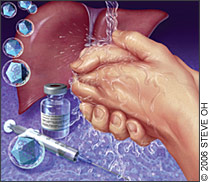
Am Fam Physician. 2006;73(12):2102
As immunization against hepatitis A virus enters its second decade, public health experts are intensifying their efforts to ensure that all children are vaccinated. In October 2005, the Centers for Disease Control and Prevention’s Advisory Committee on Immunization Practices (ACIP) recommended universal vaccination for children one year and older, and this recommendation was integrated into the 2006 child and adolescent vaccination schedule. Last month, ACIP released a report reiterating that recommendation and reaffirming its 1999 recommendations calling for vaccination of persons at increased risk of hepatitis A or its adverse consequences. This report marked the final step in ACIP’s 10-year rollout of its strategy to prevent and control hepatitis A virus infection. The Practice Guideline in this issue of AFP (page 2233) presents a summary of the ACIP report.

A Historic Low
Since hepatitis A vaccine was licensed in 1996, and particularly since ACIP’s 1999 recommendations for routine vaccination of children in areas with consistently high hepatitis A rates, national disease incidence has declined sharply. These decreases have been especially dramatic in children and in persons in the western United States, which once had the highest rates of disease. In 2004, there were 1.9 cases of hepatitis A reported per 100,000 persons; this rate is 79 percent lower than the previous record low in 1992.
From the Experts
Stephanie C. Brundage, M.D., M.P.H., and A. Nicole Fitzpatrick, M.P.H., both from the South Carolina Department of Health and Environmental Control, review the epidemiology, diagnosis, treatment, and prevention of hepatitis A in this issue of AFP (page 2162). They point out that, in addition to the drop in the number of reported cases of hepatitis A, the introduction of hepatitis A vaccines caused a shift to a higher percentage of cases being found in older age groups. This “unexpected consequence” is also noted by Jonathan L. Temte, M.D., Ph.D., the American Academy of Family Physicians’ liaison to ACIP, in his editorial (page 2127). Dr. Temte discusses the rationale for universal childhood vaccination against hepatitis A virus and reminds us that, despite the disease’s record low rates in the United States over the past decade, it continues to pose a threat. For adults with chronic hepatitis C, for example, infection with the hepatitis A virus creates a higher risk for fulminant disease, and asymptomatic infected children may act as a “silent conduit” for the virus.
Vaccination Coverage Edging Higher
In recent years, adherence to ACIP’s recommendations has led to slight increases in vaccination rates. According to the 2004 National Immunization Survey, in states for which vaccination was recommended, 54 percent of children 24 to 35 months of age had received at least one dose of hepatitis A vaccine, and in states where vaccination was to be considered, 27 percent of children had been vaccinated. With universal vaccination, hepatitis A could potentially be eradicated in the United States.
For More Information
To find additional information about ACIP’s recommendations on hepatitis A immunization, go tohttp://www.cdc.gov/mmwr/preview/mmwrhtml/rr5507a1.htm. The 2006 child and adolescent immunization schedule, which was published in the January 1, 2006, issue of AFP, is also available online athttps://www.aafp.org/afp/20060101/practice.html#p1.